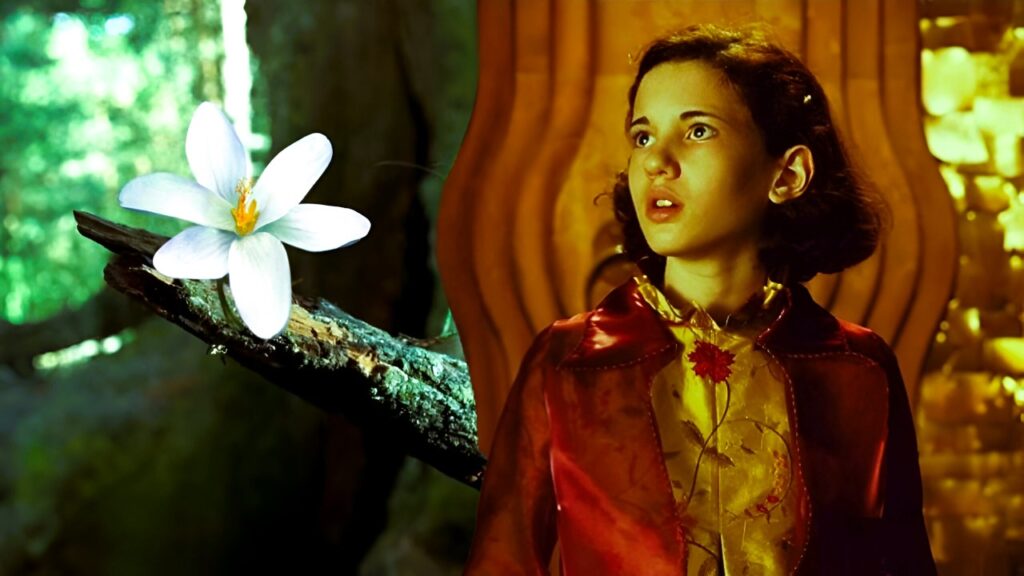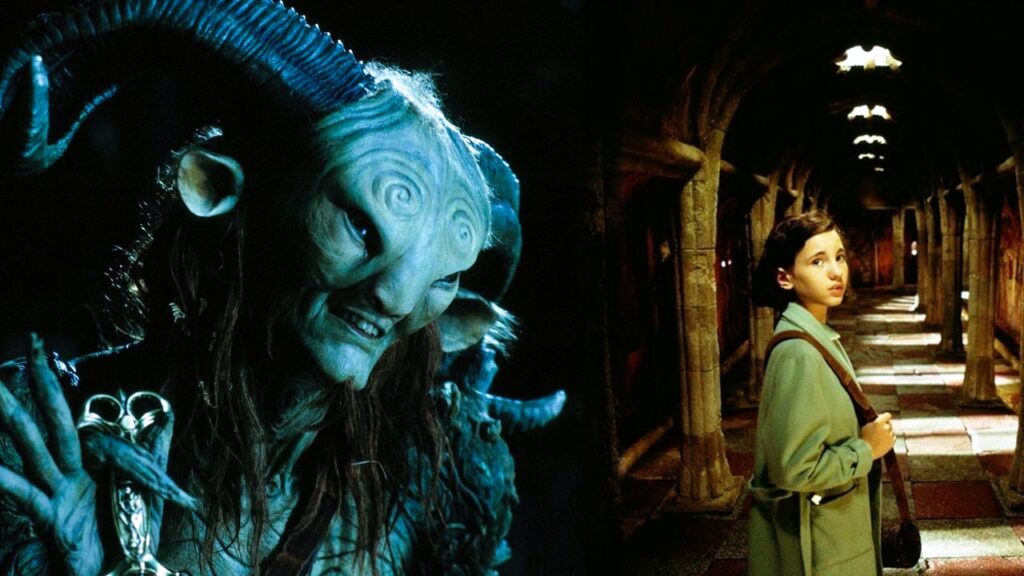This post includes a brief plot summary, an analysis, a review and an explanation about the ending of the film Pan’s Labyrinth / El laberinto del fauno (2006). Beware of spoilers.
In the depths of a war-torn Spain, a young girl’s imagination becomes her only refuge, but at what cost? Directed by Guillermo del Toro, the 2006 fantasy drama “Pan’s Labyrinth” stars Ivana Baquero as Ofelia, Sergi López as Captain Vidal and Maribel Verdú as Mercedes.
“Pan’s Labyrinth” is a haunting tale that blends fantasy and reality together. In this story, the childhood innocence of the protagonist is tested by the harsh realities of adulthood.
During Francoist Spain, a 10-year-old named Ofelia travels with her pregnant mother to meet her new stepfather, Captain Vidal. He is a ruthless, high-ranking officer whose mission is to hunt down republicans. But little does he know: the enemy has already infiltrated his house.
At Vidal’s stationary camp, Ofelia begins a fantastical journey where she finds out about her past life. While wandering around an ancient labyrinth, Ofelia meets a faun that tells her she is the reincarnation of Princess Moanna. And if she wants to regain her immortality and return to her kingdom, Ofelia must complete three tasks first.
Ofelia successfully completes the first mission, but the second does not go as well. She disobeyed the rules, causing the deaths of the two fairies. This incident, of course, angers the faun, which refused to give Ofelia her third mission.
Her strike of bad luck doesn’t end here. Vidal puts Carmen in a stressful situation, which triggers her to give birth earlier. Although Ofelia’s brother makes it, her mother does not. Vidal’s cruelty does not stop here. Earlier in the day, Vidal captured a rebel and subjected him to brutal torture. Not only that, he also murders the person who tried to help his prisoner, Doctor Ferreiro.
Vidal is well aware that the enemy is living right under his roof: his maid, Mercedes, is working for the rebels. Although she tries to escape with Ofelia, Vidal was quicker than them. The events take a turn, and Mercedes manages to run away, but Ofelia is left behind.
During Ofelia’s darkest hour, the faun reappears and gives her the third task: bring her brother to the labyrinth. But the completion of her mission requires a little sacrifice: her brother’s blood. Ofelia refuses and the faun shuns her away.
While searching for his son in the labyrinth, Vidal sees Ofelia talking to herself. He takes the baby away and shoots Ofelia. However, his time to go is about to arrive too. The rebels surround Vidal and shoot him dead.
Mercedes enters the labyrinth and finds a bleeding Ofelia on her last breath. The ending of “Pan’s Labyrinth” shows Ofelia in an alternate reality, wearing a beautiful dress and unharmed. Her parents from the underworld praise her noble choice. Ofelia passed the third test because she chose to sacrifice herself rather than an innocent person.
Guillermo del Toro uses the grim reality of the Spanish Civil War and its aftermath as a backdrop for this dark fantasy tale.
Between 1936 and 1939, Spain became a divided country because of two major political forces: the Republicans and the Nationalists. The story of “Pan’s Labyrinth” takes place after the Spanish Civil War, more specifically in 1944, meaning that General Francisco Franco was already in power at that time.
To put things in context, Mercedes and the other rebels are members of the Republican Party, while Captain Vidal and his men are members of the Nationalist Party. The political turbulence did not go away when the Spanish Civil War ended. The people opposing the Franco regime continued to fight against fascism and violence for decades until the dictatorship ended in 1975.
Obedience is a recurrent theme in the film.
Following the rules is not always the right thing to do, but not following them also has dire consequences. Doctor Ferreiro went against Vidal’s rules when he euthanised the captive rebel. Though it cost him his life, he left with his conscience clean.
Ofelia also struggled with obedience. For instance, when she refused to follow the instructions at the Pale Man’s cave, her actions caused the deaths of two fairies. But otherwise, how else was Ofelia going to learn? In addition, since she was just a kid, she was bound to make foolish mistakes. That’s what makes her a child and human.
Whether the magic in “Pan’s Labyrinth” is real or not, one thing is certain: Ofelia had a strong desire to leave her reality.
The faun did not incite Ofelia’s curiosity to live a different life, she had already been yearning for a change of environment for quite a while. First of all, there was the brutal reality of postwar Spain. Second, Ofelia’s personal life wasn’t doing that well either. Both Ofelia and her mother were hostages under Vidal’s control.

Guillermo del Toro gifted the viewers with an ambiguous ending, so they can decide what really happened.
One of the most interesting aspects of “Pan’s Labyrinth” is that it gives the audience the freedom to choose how Ofelia’s story ends. For those who are sceptics, they could interpret the whole film as Ofelia’s way of escaping her harsh reality. Nonetheless, those who are believers could also view the whole story as being “real”. They take it for its face value.
From a sceptic’s point of view, there is no magic in this story. Ofelia is just a regular girl trying to adapt to her new life as the stepdaughter of an incredibly ruthless and cruel man. Also, her mother is no longer shielding her from the harsh realities of their current situation: living in a war-torn country and having nowhere else to go.
Note: Carmen, above anyone else, knows what it’s like to make adult choices. Honestly, who would pick Vidal as a husband? A very desperate woman. Someone who was looking for a man to provide for her and her little girl.
In this case, Ofelia’s mother didn’t die because she tossed the mandrake root into the fire pit. The woman was already experiencing a lot of stress during her pregnancy. In addition, her health wasn’t the best, so there were a lot of signs that labour would be the end of her.
When Vidal was chasing Ofelia in the labyrinth, she was talking alone. There was no faun, hence, it was all in Ofelia’s head. The last scene, where Ofelia returns to her kingdom, was just a way for her to end the fantasy on a high note. She had her mother there and a male figure whom she could call a father. Ofelia projected everything she was lacking in the real world into that fantasy.
The sceptic’s theory regarding the ending of “Pan’s Labyrinth” is indeed rather gloomy. So let’s explore the believer’s perspective, which is somehow more uplifting.
From a believer’s point of view, Ofelia was indeed a princess. Though she left her physical body, her spirit was now somewhere else, in a happier place. By the way, do we have evidence in the film to support this theory? Yes.
First, Vidal locked Ofelia in her room. There was no way she could have access to Vidal’s office if it wasn’t for “magic”. She used the chalk to draw a door and Mercedes saw those lines when she came back for her.
Second, when Vidal was chasing Ofelia in the labyrinth, she actually reached a dead end and that’s why Vidal had to turn around. She was able to get away because the walls magically opened and closed again after she got in.
Third, the flower that blossoms at the end. According to the narrator, the princess left traces of her existence on Earth, but they were only visible to those who know where to look. In other words, not everyone is able to spot “magic” where it exists, which might also explain why Vidal was unable to see the faun.
Final Thoughts
“Pan’s Labyrinth” is a very strange film, but in a good way. It’s definitely a film for grown-ups, but told in a very fairy-tale-like way. The film is not shy about having violent scenes. However, that was also the reality of those times.
Ofelia is not a perfect protagonist. Sometimes, she comes off a little bratty. However, the viewers must remind themselves that she is just a kid. Even though its heroine is a child, “Pan’s Labyrinth” touches upon a lot of complex “grown-up” issues.
Overall, Pan’s Labyrinth is not an easy film to watch, some scenes were just too heartbreaking. However, if you’re a “believer”, you’ll leave the film feeling that everything ended well, just like a fairy tale. The film has one of those stories that you’ll never forget. It is definitely a timeless masterpiece.
Final Rating: 




